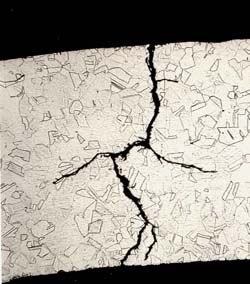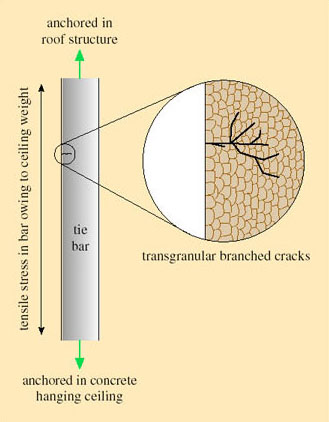

There are three main factors that work in combination to affect and cause the stress corrosion cracking of a material. What Causes Stress Corrosion Cracking (SCC)? Transgranular Stress Corrosion Cracking (TGSCC) – is where the fracture (crack) forms through the grains of a material (and not along the boundaries). Intergranular Stress Corrosion Cracking (IGSCC) – is where the fracture (crack) forms along the grain boundaries of a material. This form of corrosion can occur as either intergranular stress corrosion cracking (IGSCC) or as transgranular stress corrosion cracking (TGSCC): Hence, many SCC systems, such as caustic cracking of carbon steels, will become more susceptible as the strength decreases.Stress corrosion cracking (SCC) is the propagation of often branched cracks in a material within a corrosive environment, potentially leading to the catastrophic failure of a component/structure, as the cracking appears brittle.
GALVANIZED STEEL STRESS CORROSION CRACKING MECHANISM CRACK
Processes that rely on plastic strain at the crack tip will be easier for lower strength materials. For hydrogen embrittlement processes a higher strength normally increases the susceptibility additionally, higher strength materials generally have a low K IC, and therefore fail by fast fracture with a smaller SCC crack.

There are few general rules governing the influence of material strength on SCC susceptibility. The exact alloy composition, microstructure and heat-treatment can have a marked effect on SCC performance. The exceptions are usually pressure vessels, such as chemical reactors, high pressure gas transmission lines and steam boilers, and it is probably not insignificant that the incidence of stress corrosion failure has increased considerably over the last two decades as engineering design efficiency has improved, involving higher operating stresses and higher yield strength materials, and as the problems of corrosion spread relatively uniformly over exposed surfaces have been largely overcome, resulting in the possibility of more localized forms of corrosion. Fortunately, operating stresses are frequently below the minimum stress required for stress corrosion cracking and most instances of stress corrosion failure arise from the presence of stresses of yield stress magnitude left in structures as the result of fabrication procedures. On the other hand, if the source of the stress that drives the slow stress corrosion crack is derived from the operating conditions, the crack tip stress is not likely to relax and catastrophic failure eventually will occur.

If this is a fabrication stress, such as a residual welding stress, or if it derives from misalignment of fastener holes, crack propagation may well result in stress relief and the crack may cease to propagate if the crack tip stress intensity falls below K scc before K c is reached. Whether or not a stress corrosion crack will grow to reach the critical size for fast mechanical fracture will depend, among other factors, upon the source of the stress that initiates cracking. Where X = a factor dependent upon geometry, and σ y = yield strength. The previous equation leads to the concept of a critical crack length, C cr, in terms of the stress intensity, K scc, below which stress corrosion crack propagation does not occur, such that:

In practice, because of the relaxation and the dimensions of the component, stress intensity equations are somewhat more complex, but the principle is not altered. Where K c = fracture toughness, σ = stress, c = crack length and r y = length of the plastic zone associated with the crack. This transition occurs when the stress intensity, which is a function of the geometry of the component, including the crack size, reaches the fracture toughness value for the material concerned i.e. Their geometry is such that if they grow to appropriate lengths they may reach a critical size that results in a transition from the relatively slow crack growth rates associated with stress corrosion to the fast crack propagation rates associated with purely mechanical failure. Stress corrosion cracks propagate over a range of velocities from about 10 -3 to 10 mm/h, depending upon the combination of alloy and environment involved.


 0 kommentar(er)
0 kommentar(er)
